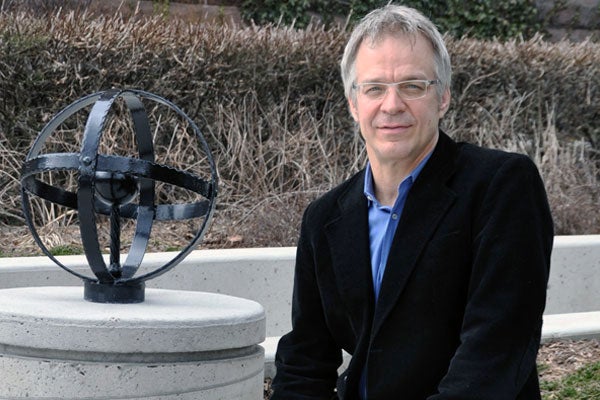
An uncanny encounter with John Zilcosky
Published: July 29, 2013
John Zilcosky, associate professor of German and Comparative Literature, was awarded a National Endowment of the Humanities fellowship for his project and forthcoming book, Uncanny Encounters: Literature, Psychoanalysis, and the End of Alterity. (Read about the NEH fellowships.)
Zilcosky, one of four Canadian university professors to receive this prestigious honour in the past eight years, sat down with writer Kelly Rankin to discuss the history of the term ‘uncanny’ and what inspired his project.
What does the term ‘uncanny’ mean?
We use ‘uncanny’ to describe all kinds of things: a haunted house, a scary movie, even a perplexing act of violence like 9/11. Yet despite our reliance on this term, most people—including me, when I started this project—have little sense of what is means or where it comes from. We have chosen a word that means everything and nothing to describe the indescribable. To make sense of things we can’t understand, we use an expression we can’t define.
This conundrum was the starting point for my project. It took me back to the uncanny’s birth years as a concept around 1900 and then even further back, to the very beginnings of its usage.
‘Uncanny’ is the English translation of the German ‘unheimlich,’ which literally means ‘un-homely,’ and, in the Middle Ages, denoted simply someone or something that was not ‘of the home’: an outsider.
Just as English has two terms—uncanny and canny—German has ‘unheimlich’ and ‘heimlich.’ These used to be opposites, but, over time, ‘heimlich’ went from meaning ‘of the home’ to ‘mysterious and secret’ (in the sense that what transpires in our homes is mysterious to those on the outside).
In the late 18th century, ‘heimlich’ started to mean not only secret but also ‘dangerous’ and ‘scary.’ In so doing, the word had evolved into its own opposite: ‘heimlich’ had become ‘unheimlich.’
At the same time that ‘heimlich’ underwent this semantic shift, so too did ‘unheimlich.’ No longer soberly describing what is beyond the home, it adopted its modern psychological connotation of ‘dreadful’ and ‘ghastly.’ A few decades later, German-language thinkers began to attempt to classify the ‘unheimlich’ philosophically. By the early twentieth century, Freud famously defined it as the frightening reappearance of the ‘homely’ where we least expect it. A concept was born.
I attempt to understand the history of the word, but my aim is not to uncover the meaning of ‘uncanny.’ I try to show how the term has changed over time and, in so doing, understand why and how we have named our unnameable fears.
Why did ‘uncanny’ come to epitomize fear in the modern era?
This new meaning gained traction after the Industrial Revolution. Urbanization and industrialization contributed to a general confusion between ‘home’ and ‘not-home’ that would have equated the ‘unheimlich’ with fear. In addition to this, three global developments produced more confusion: the mapping of the world’s last blank spaces; the Westernization of non-Europeans through colonialism; and the arrival of tourists into previously untrodden territory.
Because the ‘unheimlich’ was first conceptualized in Germany and Austria, I focus on the accounts of writers—especially travelers—from these countries. These travelers had expected the spectacularly foreign but found instead the uncannily familiar. By analyzing their encounters, I create an archive of once eminent travel writers and amateur ethnographers, and demonstrate how these travelers’ discoveries of a hauntingly recognizable world stimulated the theorizations of the uncanny by contemporary thinkers such as Freud and Heidegger, as well as writers like Mann, Hofmannsthal, Kafka, and Musil.
Why is it important to understand the term?
It can’t hurt us to understand the nature of the fears that we call uncanny. As a society, we cannot afford to shield ourselves from the things we don’t want to know about ourselves.
Part of my book is based on the assumption that we are always attempting to define home and a sense of self. This self requires an ‘other’—so that we know who we are not. Many crises occur when this ‘other’ seems too similar to us. For this reason, people who hate each other the most are often the ones who most resemble one another.
In today’s mobile, global world, we fear this blurring between ‘home’ and ‘not- home’—between self and other—more than ever. I aim to take a step toward understanding our fears and their destructiveness, and so open up possibilities for personal and political liberation.
What inspired you to write the book?
As a young boy I collected maps, and, as a teenager in the 1970s and 1980s, I colored lines on them to mark my own travels, as if to make visible my burgeoning sense of self. Then, one night over dinner, a friend of my parents told me that his own father had studied geography because he was drawn to the last white spots remaining on maps.
Imagine still dreaming of going to a blank space! Even more fascinating for me, though, was to imagine what it was like to live in the moment when that hope was steadily withdrawn. Until that moment in history, around 1900, there were always blank spaces, and European travel stories continually described the fantasy of being the first European to set foot in new worlds. But around 1900 these stories transformed into narratives of shock and fear, many of which I read while researching this book. Travelers voyaged to what should have been utterly exotic worlds only to encounter there uncanny versions of themselves.
It is no coincidence that the uncanny takes on its modern meaning at this moment when the familiar and the foreign became more confused than ever before. These everyday travelers’ shock of the uncanny prepared the way for thinkers to discover a concept that—unlike older ones—depended on the upheavals of modernity for its generation.
Kelly Rankin is a writer with University Relations at the University of Toronto.



